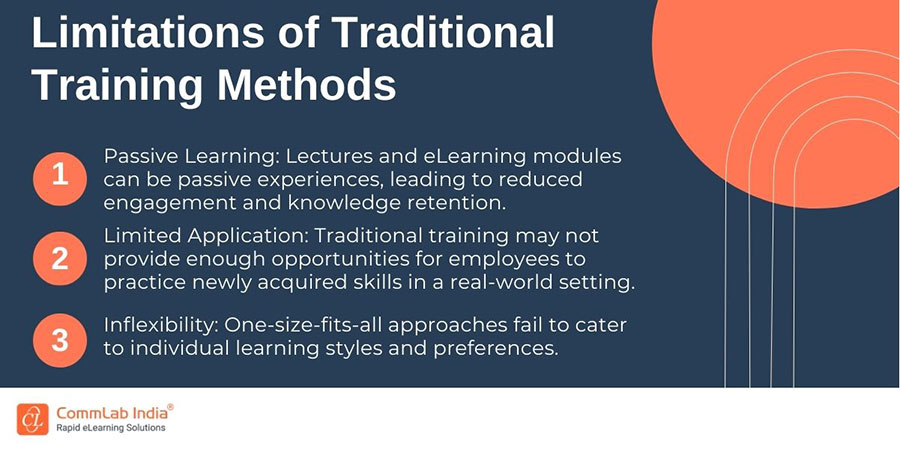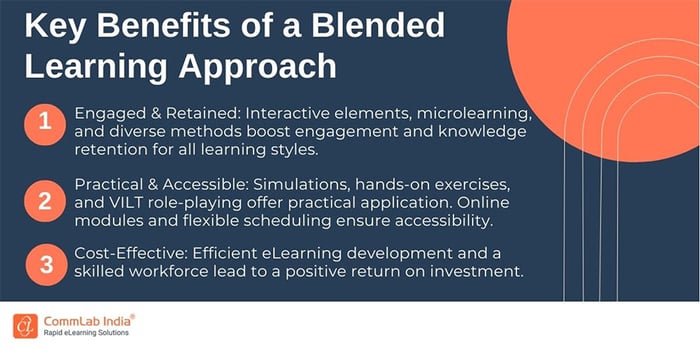How Blended Learning Approach Boosts Performance? [Guide]
Is Your Training Hitting the Mark? Boost Employee Performance with a Holistic Blended Learning Approach. Read on to discover.

Imagine this: you've invested significant resources into developing a comprehensive training program for your employees. Yet, performance metrics remain stagnant. You might be asking yourself:
Why isn't my training translating into improved employee performance?
What are the missing pieces in my current training approach?
The answer could lie in a lack of engagement. Traditional training methods, like instructor-led lectures or static eLearning modules, can often struggle to capture learner attention and promote knowledge retention. This disconnect between training and its impact on employee performance is where a holistic blended learning approach comes in.
How Does Holistic Blended Learning Benefit Corporate Training?
- Offers higher employee engagement as they have both face-to-face interactions with trainers and access to online materials.
- Empowers employees to learn independently and face-to-face, reducing dependency on trainers.
- Encourages flexibility. Learners can pace their learning, and trainers can efficiently manage large groups.
- Helps save time and money, especially for multinational companies with dispersed teams.
This blog will explore the importance of employee performance, delve into the limitations of traditional training methods, and unveil the benefits of a blended learning approach. We'll also provide practical tips on how to design and implement a blended learning program for your organization, incorporating a variety of powerful tools and instruction methods.
Why is Employee Performance Important and What is the Role of Training?
Employee performance is the cornerstone of any successful organization. It directly impacts factors like productivity, customer satisfaction, and ultimately, your bottom line. Highly skilled and engaged employees are more likely to:
Deliver exceptional results: They possess the knowledge and skills required to handle day-to-day workplace challenges and consistently deliver high-quality work.
Drive innovation: Engaged employees are more likely to think outside the box and contribute creative solutions to problems.
Become brand ambassadors: Satisfied employees who feel empowered by their training are more likely to represent your company positively.
Investing in employee training demonstrates your commitment to their development and growth. Effective training programs provide your workforce with the tools and knowledge they need to excel in their roles. However, traditional training methods often face limitations:

These limitations can lead to a disconnect between training and its impact on employee performance.
How Blended Learning Approach to Training Boosts Employee Performance?
What is Blended Learning? [Video]
A blended learning approach combines various training methods to create a comprehensive and engaging learning experience. This approach can address the limitations of traditional methods and foster a more effective learning environment.
Here are some key benefits of a blended learning approach, incorporating the power of various tools and instruction methods:

Different Types of Instruction Methods in Blended Learning
Blended learning offers a flexible framework that allows you to leverage a variety of instruction methods to cater to different learning styles and training objectives. Here's a closer look at some popular methods:
Instructor-Led Training (ILT): This traditional method involves a facilitator leading a session in a classroom setting. ILT sessions can be highly interactive, allowing for discussions, Q&A, and group activities.
Virtual Instructor-Led Training (VILT): VILT replicates the ILT experience in a virtual environment. Learners attend sessions online, and instructors can utilize interactive tools and breakout rooms to facilitate engagement.
Microlearning: These bite-sized learning modules focus on specific skills or knowledge points. They can be delivered online in short bursts, making them ideal for busy schedules and promoting focused learning.
Video-Based Learning: Videos can be a powerful tool for visual learners. They can be used to demonstrate procedures, showcase real-world scenarios, and deliver expert insights.
Rapid eLearning Modules: These online modules can be developed quickly and efficiently to introduce new concepts or provide basic knowledge checks.
Simulations: Simulations allow learners to practice skills in a safe and controlled environment. This can be particularly beneficial for training on complex procedures or high-risk situations.
Hands-on Practice Exercises: Providing opportunities for employees to apply newly acquired skills in a practical setting is crucial for knowledge retention and skill development.
Gamification: By incorporating game mechanics like points, badges, and leaderboards, you can boost learner motivation and make the learning process more engaging.
→ Access eBook: Blended Learning to Accelerate Time to Proficiency
Building a Successful Blended Learning Program
1. Define Your Learning Objectives
What specific skills or knowledge do you want your employees to gain? Clearly defined objectives will guide the selection of appropriate instruction methods within your blended learning program.
2. Identify the Ideal Mix of Approaches
Consider incorporating a combination of the instruction methods mentioned above, such as instructor-led sessions for complex concepts, microlearning for quick knowledge checks, video-based learning for visual learners, and **hands-on practice exercises.
3. Leverage Technology
Utilize a robust Learning Management System (LMS) to deliver online modules, track learner progress across various instruction methods (ILT attendance, microlearning completion, etc.), facilitate communication through discussion forums, and manage the entire blended learning program. An LMS can be a central hub for all your training materials, keeping learners organized and engaged.
4. Prioritize Engagement
Don't underestimate the power of keeping learners engaged throughout the blended learning program. Integrate interactive elements like quizzes, polls, and collaborative activities into ILT sessions and VILT sessions. Incorporate gamification features like points and badges into online modules or microlearning activities. Encourage participation in discussion forums and provide opportunities for peer-to-peer learning.
5. Measure and Adapt
Tracking learner performance and program effectiveness is crucial for continuous improvement. Utilize the data collected through your LMS to assess knowledge retention through quizzes or assessments delivered after different instruction methods. Gather learner feedback through surveys or focus groups to understand their experience and preferences. Based on this data, you can refine your blended learning program by adjusting the mix of instruction methods, tailoring content to address knowledge gaps, and enhancing the overall learning experience.
Parting Thoughts
In today's competitive landscape, a well-designed blended learning program can be the key to unlocking your employees' full potential. By combining different instruction methods like VILT, microlearning, video-based learning, etc, all managed through a robust LMS, you can create a holistic and engaging training experience. This approach fosters improved knowledge retention, promotes practical skill development, and ultimately translates to a more skilled and productive workforce.
Ready to take your training to the next level? Embrace the power of blended learning and empower your employees with the tools they need to thrive. Explore more about the approach in our eBook:
Download Now:





